Category: Recommended Reading
On ‘There’s No Such Thing As An Easy Job’
Rebecca Liu at Prospect Magazine:
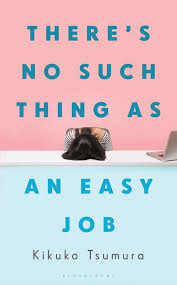 “God,” a friend of mine recently confided to me, “needs to make a comeback.”
“God,” a friend of mine recently confided to me, “needs to make a comeback.”
She sounded like she was joking, she continued, but she wasn’t. Growing up in the overwhelmingly secularised milieu of millennial city-dwellers was not delivering her any meaning, particularly during the era of Covid-19. The already apparently trivial demands she faced daily at work seemed to not slow down, but rather accelerate. Her bosses were still urgently demanding her to work to an increasingly arbitrary schedule; clients still desperately needed action from her, today. At a time of mass suffering, there seemed little to reflect on how best to live.
The protagonist in Kikuko Tsumura’s There’s No Such Thing As An Easy Job, translated by Polly Barton (and the first of Tsumura’s novels to be translated into English), lives in a world bereft of meaning, flitting between—like my friend, like most of us—roles that promise us a respectable claim to adult life: jobs.
more here.
Remembering Jan Morris
The Editors at The Paris Review:
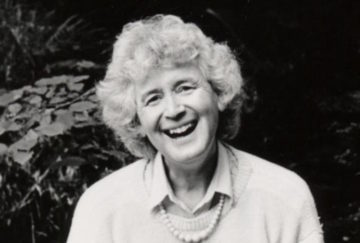 Wales mattered to Jan. In midlife, and at more or less the same time as her gender reassignment, she embraced what she called Welsh Republicanism. Her home, Trefan Morys, is in a remote area near the town of Criccieth. You leave the main road, take a long, rutted drive, negotiate the narrow entrance in a high stone wall, and you are suddenly in an enchanted space. Elizabeth was the architect of the garden and Jan the interior designer. You enter the house through a two-part stable door (Jan always greeting you with the words, “Not today, thank you”), into a cozy kitchen, and then the main downstairs room. The walls are lined with eight thousand books, including specially leather-bound editions of Jan’s own. Up the stairs there is another long room, with an old-fashioned stove in the middle. Here are more books, but this space is given over mainly to memorabilia and paintings. Pride of place is given to a six-foot-long painting of Venice, done by Jan, in which every detail of the miraculous city is rendered (including tiny portraits of the two eldest sons, who were very young at the time Jan painted it). Model ships hang from the ceiling, and paintings of ships adorn the walls. Jan loved ships from the time she spied them, as a child, through a telescope as they passed through the Bristol Channel near her family’s home.
Wales mattered to Jan. In midlife, and at more or less the same time as her gender reassignment, she embraced what she called Welsh Republicanism. Her home, Trefan Morys, is in a remote area near the town of Criccieth. You leave the main road, take a long, rutted drive, negotiate the narrow entrance in a high stone wall, and you are suddenly in an enchanted space. Elizabeth was the architect of the garden and Jan the interior designer. You enter the house through a two-part stable door (Jan always greeting you with the words, “Not today, thank you”), into a cozy kitchen, and then the main downstairs room. The walls are lined with eight thousand books, including specially leather-bound editions of Jan’s own. Up the stairs there is another long room, with an old-fashioned stove in the middle. Here are more books, but this space is given over mainly to memorabilia and paintings. Pride of place is given to a six-foot-long painting of Venice, done by Jan, in which every detail of the miraculous city is rendered (including tiny portraits of the two eldest sons, who were very young at the time Jan painted it). Model ships hang from the ceiling, and paintings of ships adorn the walls. Jan loved ships from the time she spied them, as a child, through a telescope as they passed through the Bristol Channel near her family’s home.
more here.
Jan Morris
NHS to trial blood test that can detect over 50 cancer types
From Medical Device Network:
 The UK National Health Service (NHS) is set to initiate the trial of Galleri blood test that can potentially detect over 50 types of cancers. Developed by GRAIL, the test is capable of detecting early-stage cancers through a simple blood test. In research on patients with cancer signs, the test identified many types like head and neck, ovarian, pancreatic, oesophageal and some blood cancers, which are difficult to diagnose early. The blood test checks for molecular changes. NHS Chief Executive Simon Stevens said: “Early detection – particularly for hard-to-treat conditions like ovarian and pancreatic cancer – has the potential to save many lives. “This promising blood test could therefore be a game-changer in cancer care, helping thousands of more people to get successful treatment.” Anticipated to start in the middle of next year, the GRAIL pilot will involve 165,000 people. This participant population will include 140,000 people aged 50 to 79 years who have no symptoms but will have annual blood tests for three years.
The UK National Health Service (NHS) is set to initiate the trial of Galleri blood test that can potentially detect over 50 types of cancers. Developed by GRAIL, the test is capable of detecting early-stage cancers through a simple blood test. In research on patients with cancer signs, the test identified many types like head and neck, ovarian, pancreatic, oesophageal and some blood cancers, which are difficult to diagnose early. The blood test checks for molecular changes. NHS Chief Executive Simon Stevens said: “Early detection – particularly for hard-to-treat conditions like ovarian and pancreatic cancer – has the potential to save many lives. “This promising blood test could therefore be a game-changer in cancer care, helping thousands of more people to get successful treatment.” Anticipated to start in the middle of next year, the GRAIL pilot will involve 165,000 people. This participant population will include 140,000 people aged 50 to 79 years who have no symptoms but will have annual blood tests for three years.
Those tested positive will be referred for investigation in the NHS.
Furthermore, another 25,000 people with possible cancer symptoms will be offered testing to fast-track their diagnosis after being referred to a hospital in the normal way. The results of these studies should be available by 2023. On obtaining positive outcomes, the study will expand around one million participants in 2024 and 2025.
More here.
The Science Behind Dreaming
Sander van der Linden in Scientific American:
 For centuries people have pondered the meaning of dreams. Early civilizations thought of dreams as a medium between our earthly world and that of the gods. In fact, the Greeks and Romans were convinced that dreams had certain prophetic powers. While there has always been a great interest in the interpretation of human dreams, it wasn’t until the end of the nineteenth century that Sigmund Freud and Carl Jung put forth some of the most widely-known modern theories of dreaming. Freud’s theory centred around the notion of repressed longing — the idea that dreaming allows us to sort through unresolved, repressed wishes. Carl Jung (who studied under Freud) also believed that dreams had psychological importance, but proposed different theories about their meaning.
For centuries people have pondered the meaning of dreams. Early civilizations thought of dreams as a medium between our earthly world and that of the gods. In fact, the Greeks and Romans were convinced that dreams had certain prophetic powers. While there has always been a great interest in the interpretation of human dreams, it wasn’t until the end of the nineteenth century that Sigmund Freud and Carl Jung put forth some of the most widely-known modern theories of dreaming. Freud’s theory centred around the notion of repressed longing — the idea that dreaming allows us to sort through unresolved, repressed wishes. Carl Jung (who studied under Freud) also believed that dreams had psychological importance, but proposed different theories about their meaning.
Since then, technological advancements have allowed for the development of other theories. One prominent neurobiological theory of dreaming is the “activation-synthesis hypothesis,” which states that dreams don’t actually mean anything: they are merely electrical brain impulses that pull random thoughts and imagery from our memories. Humans, the theory goes, construct dream stories after they wake up, in a natural attempt to make sense of it all. Yet, given the vast documentation of realistic aspects to human dreaming as well as indirect experimental evidence that other mammals such as cats also dream, evolutionary psychologists have theorized that dreaming really does serve a purpose. In particular, the “threat simulation theory” suggests that dreaming should be seen as an ancient biological defence mechanism that provided an evolutionary advantage because of its capacity to repeatedly simulate potential threatening events – enhancing the neuro-cognitive mechanisms required for efficient threat perception and avoidance.
So, over the years, numerous theories have been put forth in an attempt to illuminate the mystery behind human dreams, but, until recently, strong tangible evidence has remained largely elusive.
More here.
Friday Poem
Immigrant Confession
The Cherokee are not originally from Oklahoma. Settlers forced
them to disappear west, into air and sky, beyond buildings,
beyond concrete, beyond the rabid land hunger. There was
a trail. There was despair. Reservations carved out of prairie
grass, lost space and sadness in the middle of flat dirt. We landed
in March 1980. We knew nothing about the Cherokee.
Settlers from the South, driven by opportunities and education,
looking for the gold and gifts of immigration, we hid our Spanish,
the shame of accents and poverty, immersed ourselves in cowboy
ways. In school we learned English, read about open, endless
land, a territory there by divine right for those willing, chosen
to till and build, for those exiled, broken out of other lands.
Every spring the second grade celebrated the land rush. Half of us
immigrants flung across the globe, we wanted to be part of the story.
We gathered in costume behind the chalk line in a field across from
Westbury elementary. Girls in calico skirts, bonnets, ruffled blouses.
Boys in straw hats, borrowed cowboy boots, chaps strapped with toy guns.
Parents and picnic lunches waited on the sidelines. The cap gun popped.
The second grade scattered wild, stakes in hand running, ready to claim
our piece of promised land. My parents celebrated the land rush twice,
two of us old enough to live into the strange alchemy of assimilation.
I learned later our stakes professed death, bloodied limbs, hacked up
hearts, bodies crushed, taken from the arid land with the wave of a flag,
the pulsing stampede of wagons, the firing of the starting gun,
disappeared with every second-grade spring picnic.
Two million acres of territory taken in the first land rush.
My immigrant confession: I have ached for my Oklahoma childhood,
my territory story, when the land gave again, held a promise of country
after exile. I have mourned the second-grade land rush, the look on
my parents’ faces as we galloped into yellow grass, screaming breathless
in joy and wildness, when they imagined an America big enough,
wide enough, whole enough to let us in, whole enough not to break us.
.
by M. Soledad Caballero
from Split this Rock
Soledad Caballero reading “Immigrant Confession.”
Thursday, November 26, 2020
The Substack Discourse and the Self-Referentiality of Everything
Justin E. H. Smith in his Substack Newsletter:
 You might recall the strange case of Matthew J. Mayhew, professor of educational administration at The Ohio State University. In late September he published an opinion piece in Inside Higher Ed enumerating the many supposed virtues of college football. A week later he issued, in the same venue, an abject apology for his first piece, in which, he now confessed, he had failed to recognise the various ways his support for collegiate athletics perpetuated white supremacy and failed to center the voices of people of colour. “I am just beginning to understand,” he wrote, “how I have harmed communities of color with my words. I am learning that my words —my uninformed, careless words— often express an ideology wrought in whiteness and privilege.”
You might recall the strange case of Matthew J. Mayhew, professor of educational administration at The Ohio State University. In late September he published an opinion piece in Inside Higher Ed enumerating the many supposed virtues of college football. A week later he issued, in the same venue, an abject apology for his first piece, in which, he now confessed, he had failed to recognise the various ways his support for collegiate athletics perpetuated white supremacy and failed to center the voices of people of colour. “I am just beginning to understand,” he wrote, “how I have harmed communities of color with my words. I am learning that my words —my uninformed, careless words— often express an ideology wrought in whiteness and privilege.”
One could not help but try to imagine the struggle session to which Mayhew was subjected that week, from which he emerged as if reborn. It seems hard to deny that he is sincere in his follow-up piece —the common view that he is writing as if there is a gun held to his head misses the mark—, but also totally and radically converted from one way of seeing the world to another, a conversion that can typically only occur where there is significant social and institutional pressure.
More here.
How scientists developed the Oxford vaccine at breakneck speed
Ian Sample in The Guardian:
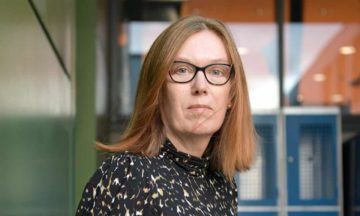 At the heart of Oxford’s effort to produce a Covid vaccine are half a dozen scientists who between them brought decades of experience to the challenge of designing, developing, manufacturing and trialling a safe vaccine at breakneck speed.
At the heart of Oxford’s effort to produce a Covid vaccine are half a dozen scientists who between them brought decades of experience to the challenge of designing, developing, manufacturing and trialling a safe vaccine at breakneck speed.
Prof Sarah Gilbert, the Kettering-born project leader, arrived at Oxford in 1994 to work with Prof Adrian Hill, a senior member of the team, on the malaria parasite, plasmodium. She soon fell into work on experimental vaccines, starting with one that roused white blood cells to fight malaria, followed by a “universal” flu vaccine.
As a student, Gilbert is said to have knitted cardigans with dogs on and played her saxophone in the woods to avoid disturbing her neighbours. As a researcher at Oxford, she gained a no-nonsense reputation, which some attribute in part to her raising triplets, though her husband gave up work to parent them.
Oxford’s coronavirus work built on research pioneered by Hill and Gilbert on vaccines based on a virus that causes common colds in chimpanzees.
More here.
The Plot and the Argument: Philosophy as a Narrative Affair
Costica Bradatan in the Los Angeles Review of Books:
 “AND WHAT ABOUT unbiased research? What about pure knowledge?” bursts out the more idealistic of the two debaters. Before the other, the more cynical one, even has a chance to answer, the idealist ambushes him with even grander questions: “What about the truth, my dear sir, which is so intimately bound up with freedom, and its martyrs?” We can picture the caustic smile on the cynic’s face. “My good friend,” the cynic answers, “there is no such thing as pure knowledge.” His words come out calmly, fully formed, in sharp contrast to the idealist’s passionate, if sometimes logically disjointed pronouncements. The cynic’s rebuttal is merciless:
“AND WHAT ABOUT unbiased research? What about pure knowledge?” bursts out the more idealistic of the two debaters. Before the other, the more cynical one, even has a chance to answer, the idealist ambushes him with even grander questions: “What about the truth, my dear sir, which is so intimately bound up with freedom, and its martyrs?” We can picture the caustic smile on the cynic’s face. “My good friend,” the cynic answers, “there is no such thing as pure knowledge.” His words come out calmly, fully formed, in sharp contrast to the idealist’s passionate, if sometimes logically disjointed pronouncements. The cynic’s rebuttal is merciless:
Faith is the vehicle of understanding, the intellect is secondary. Your unbiased science is a myth. Faith, a world view, an idea — in short, the will — is always present, and it is then reason’s task to examine and prove it. In the end we always come down to “quod erat demonstrandum.” The very notion of proof contains, psychologically speaking, a strong voluntaristic element.
To the idealist, brought up in the grand tradition of the European Enlightenment, this looks like a mockery of all he stands for. He can’t take the cynic’s reasoning other than as a tasteless joke.
More here.
Thanksgiving Day: How an ‘Indian bird’ made its way to the American dinner table
Vivek Menezes in Scroll.in:
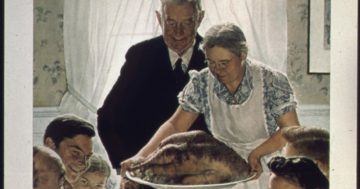 Our quest centres on this simple question: why do so many languages and cultures identify these North American natives as “the birds from India” (oiseaux d’Inde, or simply dinde in French).
Our quest centres on this simple question: why do so many languages and cultures identify these North American natives as “the birds from India” (oiseaux d’Inde, or simply dinde in French).
I believe one important clue is what the Turks call it themselves: Hindi (or simply, “from India). Another is the terms used by the Dutch and assorted Scandinavians, which are all variations of kalcun, indicating the specific origin of Calicut on India’s west coast.
Here, we should note many people have considered these same exact facts, and dismissed the idea there’s anything complicated to be ferreted out. Their logic goes this way: Columbus thought he’d arrived in India, and just as Native Americans were called Indians, that’s why so many Europeans referred to “the Indian bird”.
More here.
Barack Obama Joins YouTube’s Viral Reaction Twins
A Thanksgiving like no other: Finding uplift in a dark year
Michael Hopkins in Christian Science Monitor:
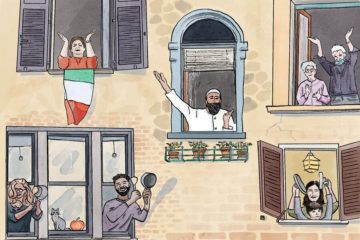 Truth is, this year has seen plenty of gratitude, instinctively and generously expressed. The people applauding out their windows for emergency responders, the heart signs, the food deliveries to essential workers, the neighborhood trash teams, the looking-in on elders. Online platforms as purpose-built as gratefulness.org and as customarily combative as Twitter have been flooded with counted blessings: for our loved ones, for the Amazon carrier, for our dogs. People gave thanks for simple things, mostly – their families, video chats, the “tall green trees that are older than me,” a hummingbird, the ocean, soup. (“Yep, soup,” says a West Sacramento, California, man.) But many, many other expressions of gratitude took the form of generosity, of trying to give back or pay it forward. The news was filled with stories of people in grocery lines paying for the customer coming next, donations to farmworkers, businesses furnishing free meals to front-line responders.
Truth is, this year has seen plenty of gratitude, instinctively and generously expressed. The people applauding out their windows for emergency responders, the heart signs, the food deliveries to essential workers, the neighborhood trash teams, the looking-in on elders. Online platforms as purpose-built as gratefulness.org and as customarily combative as Twitter have been flooded with counted blessings: for our loved ones, for the Amazon carrier, for our dogs. People gave thanks for simple things, mostly – their families, video chats, the “tall green trees that are older than me,” a hummingbird, the ocean, soup. (“Yep, soup,” says a West Sacramento, California, man.) But many, many other expressions of gratitude took the form of generosity, of trying to give back or pay it forward. The news was filled with stories of people in grocery lines paying for the customer coming next, donations to farmworkers, businesses furnishing free meals to front-line responders.
…So it has always been, this idea of hardship as a whetstone for which thanks are due. It’s easy to forget that the official Thanksgiving holiday we know today did not even exist until Abraham Lincoln created it during that hardest of national hardships, the Civil War. On Oct. 3, 1863 – just weeks before he would go to Gettysburg to give his famous address – he issued a proclamation that thanks “should be solemnly, reverently and gratefully acknowledged as with one heart and one voice by the whole American People,” and that it should be done on the last Thursday of each November. The proclamation didn’t quail from noting that the country was, indeed, “in the midst of a civil war of unequaled magnitude and severity.” And it humbly suggested that any prayers offered up might particularly “commend to His tender care all those who have become widows, orphans, mourners or sufferers.” Nevertheless, the president observed, it still was a time of peace overseas, of bounty in the fields and mines, of lawfulness in the villages.
According to Arthur Brooks, who teaches a course on happiness at Harvard Business School, “Psychologists have found that many of the most meaningful experiences in life are quite painful.”
More here.
The Art of Building the Impossible
Burkhard Bilger in The New York Times:
 Mark Ellison stood on the raw plywood floor, staring up into the gutted nineteenth-century town house. Above him, joists, beams, and electrical conduits crisscrossed in the half-light like a demented spider’s web. He still wasn’t sure how to build this thing. According to the architect’s plans, this room was to be the master bath—a cocoon of curving plaster shimmering with pinprick lights. But the ceiling made no sense. One half of it was a barrel vault, like the inside of a Roman basilica; the other half was a groin vault, like the nave of a cathedral. On paper, the rounded curves of one vault flowed smoothly into the elliptical curves of the other. But getting them to do so in three dimensions was a nightmare. “I showed the drawings to the bass player in my band,” Ellison said. “He’s a physicist, so I asked him, ‘Could you do the calculus for this?’ He said, ‘No.’ ”
Mark Ellison stood on the raw plywood floor, staring up into the gutted nineteenth-century town house. Above him, joists, beams, and electrical conduits crisscrossed in the half-light like a demented spider’s web. He still wasn’t sure how to build this thing. According to the architect’s plans, this room was to be the master bath—a cocoon of curving plaster shimmering with pinprick lights. But the ceiling made no sense. One half of it was a barrel vault, like the inside of a Roman basilica; the other half was a groin vault, like the nave of a cathedral. On paper, the rounded curves of one vault flowed smoothly into the elliptical curves of the other. But getting them to do so in three dimensions was a nightmare. “I showed the drawings to the bass player in my band,” Ellison said. “He’s a physicist, so I asked him, ‘Could you do the calculus for this?’ He said, ‘No.’ ”
Straight lines are easy, curves are hard. Most houses are just collections of boxes, Ellison says. We stack them side by side or on top of one another, like toddlers playing with blocks. Add a triangular roof and it’s done. When buildings were still made by hand, the process would yield the occasional curve—igloos, mud huts, wigwams, yurts—and master builders earned their keep with arches and domes. But flat shapes are cheaper to mass-produce, and every sawmill and factory spits them out in uniform sizes: bricks, boards, drywall, tile. It’s the tyranny of the orthogonal, Ellison says.
“I can’t do the calculus on this, either,” he added, shrugging. “But I can build it.” Ellison is a carpenter—the best carpenter in New York, by some accounts, though that hardly covers it. Depending on the job, Ellison is also a welder, a sculptor, a contractor, a cabinetmaker, an inventor, and an industrial designer. He’s a carpenter the way Filippo Brunelleschi, the architect of the great dome of the Florence Cathedral, was an engineer. He’s a man who gets hired to build impossible things.
More here. (Note: For Jaffer Kolb, the best architect I know)
The AI GPT-3 Writes About Dating
Cade Metz at the NYT:
 He called the next day. We went out for lunch. We went out for dinner. We went out for drinks. We went out for dinner again. We went out for drinks again. We went out for dinner and drinks again. We went out for dinner and drinks and dinner and drinks and dinner and drinks and dinner and drinks and dinner and drinks and dinner and drinks and dinner and drinks and dinner and drinks and dinner and drinks and dinner and drinks and dinner and drinks and dinner and drinks and dinner and drinks and dinner and drinks and dinner and drinks and dinner and drinks and dinner and drinks and dinner and drinks and dinner and drinks and dinner and drinks and dinner and drinks and dinner and drinks and dinner and drinks and dinner and drinks and dinner and drinks and dinner and drinks and dinner and drinks and dinner and drinks and dinner and drinks and dinner and drinks and dinner and drinks and dinner and drinks and dinner and drinks and dinner and drinks and dinner and drinks and dinner and drinks and dinner and drinks and dinner and drinks and dinner and drinks and dinner and drinks and dinner and drinks and dinner and drinks and dinner and drinks and dinner and drinks and dinner and drinks and dinner and drinks and dinner and drinks and dinner and drinks and dinner and drinks and dinner and drinks and dinner and drinks and dinner and drinks and dinner and drinks and dinner and drinks and dinner and drinks and
He called the next day. We went out for lunch. We went out for dinner. We went out for drinks. We went out for dinner again. We went out for drinks again. We went out for dinner and drinks again. We went out for dinner and drinks and dinner and drinks and dinner and drinks and dinner and drinks and dinner and drinks and dinner and drinks and dinner and drinks and dinner and drinks and dinner and drinks and dinner and drinks and dinner and drinks and dinner and drinks and dinner and drinks and dinner and drinks and dinner and drinks and dinner and drinks and dinner and drinks and dinner and drinks and dinner and drinks and dinner and drinks and dinner and drinks and dinner and drinks and dinner and drinks and dinner and drinks and dinner and drinks and dinner and drinks and dinner and drinks and dinner and drinks and dinner and drinks and dinner and drinks and dinner and drinks and dinner and drinks and dinner and drinks and dinner and drinks and dinner and drinks and dinner and drinks and dinner and drinks and dinner and drinks and dinner and drinks and dinner and drinks and dinner and drinks and dinner and drinks and dinner and drinks and dinner and drinks and dinner and drinks and dinner and drinks and dinner and drinks and dinner and drinks and dinner and drinks and dinner and drinks and dinner and drinks and dinner and drinks and dinner and drinks and dinner and drinks and dinner and drinks and
more here.
Thursday Poem
Brain
is
most like
a priest
who revels in
the body’s feast
and says
to much
and asks
how Long
and sings his own
electric song
until he totters
on his shelf
and as he falls
forgives himself
by John Stone
from In All This Rain
Louisiana State University Press, 1980
Wednesday, November 25, 2020
What Is the Best Strategy to Deploy a Covid-19 Vaccine?
Jill Neimark in Undark:
 IF THE BOOK of nature is written in the language of mathematics, as Galileo once declared, the Covid-19 pandemic has brought that truth home for the world’s mathematicians, who have been galvanized by the rapid spread of the coronavirus.
IF THE BOOK of nature is written in the language of mathematics, as Galileo once declared, the Covid-19 pandemic has brought that truth home for the world’s mathematicians, who have been galvanized by the rapid spread of the coronavirus.
So far this year, they have been involved in everything from revealing how contagious the novel coronavirus is, how far we should stand from each other, how long an infected person might shed the virus, how a single strain spread from Europe to New York and then burst across America, and how to ‘’flatten the curve’‘ to save hundreds of thousands of lives. Modeling also helped persuade the Centers for Disease Control and Prevention that the virus can be airborne and transmitted by aerosols that stay aloft for hours.
And at the moment many are grappling with a particularly urgent — and thorny — area of research: modeling the optimal rollout of a vaccine. Because vaccine supply will be limited at first, the decisions about who gets those first doses could save tens of thousands of lives. This is critical now that promising early results are coming in about two vaccine candidates — one from Pfizer and BioNTech and one from Moderna — that may be highly effective and for which the companies may apply for emergency authorization from the Food and Drug Administration.
But figuring out how to allocate vaccines — there are close to 50 in clinical trials on humans — to the right groups at the right time is “a very complex problem,” says Eva Lee, director of the Center for Operations Research in Medicine and Health Care at the Georgia Institute of Technology. Lee has modeled dispensing strategies for vaccines and medical supplies for Zika, Ebola, and influenza, and is now working on Covid-19.
More here.
Mark Blyth talks with Luke Messac: What Malawi Tells Us About the Construction of Scarcity
The Oligarchy Loves This Democratic Decay and Politics of Lies
Chris Hedges in Common Dreams:
 Joe Biden’s victory instantly obliterated the Democratic Party’s longstanding charge that Russia was hijacking and compromising US elections. The Biden victory, the Democratic Party leaders and their courtiers in the media now insist, is evidence that the democratic process is strong and untainted, that the system works. The elections ratified the will of the people.
Joe Biden’s victory instantly obliterated the Democratic Party’s longstanding charge that Russia was hijacking and compromising US elections. The Biden victory, the Democratic Party leaders and their courtiers in the media now insist, is evidence that the democratic process is strong and untainted, that the system works. The elections ratified the will of the people.
But imagine if Donald Trump had been reelected. Would the Democrats and pundits at The New York Times, CNN and MSNBC pay homage to a fair electoral process? Or, having spent four years trying to impugn the integrity of the 2016 presidential race, would they once again haul out the blunt instrument of Russian interference to paint Trump as Vladimir Putin’s Manchurian candidate?
Trump and Giuliani are vulgar and buffoonish, but they play the same slimy game as their Democratic opponents. The Republicans scapegoat the deep state, communists and now, bizarrely, Venezuela; the Democrats scapegoat Russia. The widening disconnect from reality by the ruling elite is intended to mask their complicity in the seizure of power by predatory global corporations and billionaires.
More here.
